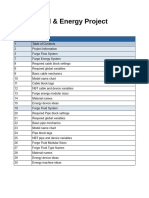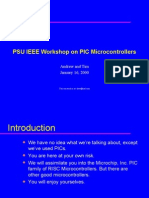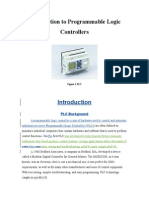Arduino Timer Interrupts
Uploaded by
bugaboo2323Arduino Timer Interrupts
Uploaded by
bugaboo2323Microcontroller tutorial series: AVR and Arduino timer interrupts
Does your program seem like its trying to do too much at once? Are you using a lot of d e l a y ( )or w h i l e ( )loops that are holding other things up? If so, your project is a good candidate to use timers. In this tutorial, well discuss AVR and Arduino timers and how to use them to write better code. In our prior article, we covered interrupt basics and how to use external interrupts that are triggered by a pin change or similar event. Check it out if youre looking to brush up on interrupts in general. This chapter moves on to timer interrupts and talks about their applications in Arduino projects or custom AVR circuits. Almost all Arduino boards are powered by AVR 8-bit processors, so to experience the full power of timers youll use the same techniques no matter which platform youre on. Heres the tutorials table of contents: What is a timer? How do timers work? Types of timers Configuring and running the timer Timer prescaling and CTC Going further
What is a timer?
Youre probably familiar with the general concept of a timer: something used to measure a given time interval. In microcontrollers, the idea is the same. You can set a timer to trigger an interrupt at a certain point in the future. When that point arrives, you can use the interrupt as an alert, run different code, or change a pin output. Think of it as an alarm clock for your processor. The beauty of timers is that just like external interrupts, they run asynchronously, or independently from your main program. Rather than running a loop or repeatedly calling m i l l i s ( ) , you can let a timer do that work for you while your code does other things. For example, say youre building a security robot. As it roams the halls, you want it to blink an LED every two seconds to let potential intruders know theyll be vaporized if they make a wrong move. Using normal code techniques, youd have to set a variable with the next time the LED should blink, then check constantly to see if that time had arrived. With a timer interrupt, you can set up the interrupt, then turn on the timer. Your LED will blink perfectly on cue, even while your main program executes its complicated t e r m i n a t e V i l l i a n ( ) routine.
How do timers work?
Timers work by incrementing a counter variable, also known as a counter register. The counter register can count to a certain value, depending on its size. The timer increments this counter one step at a time until it reaches its maximum value, at which point the counter overflows , and resets back to zero. The timer normally sets a flag bit to let you know an overflow has occurred. You can check this flag manually, or you can also have the timer trigger an interrupt as soon as the flag is set. Like any other interrupt, you can specify an Interrupt Service Routine (ISR) to run code of your choice when the timer overflows. The ISR will reset the overflow flag behind the scenes, so using interrupts is usually your best option for simplicity and speed. In order to increment the counter value at regular intervals, the timer must have access to a clock source. The clock source generates a consistent repeating signal. Every time the timer detects this signal, it increases its counter by one. Because timers are dependent on the clock source, the smallest measurable unit of time will be the period of this clock. For example, if we provide a 1 MHz clock signal to a timer, we can calculate our timer resolution (or timer period) as follows:
T=t i m e rp e r i o d ,f=c l o c kf r e q u e n c y T=1/f T=1/1M H z=1/1 0 ^ 6H z T=( 1*1 0 ^ 6 )s
Our timer resolution is one millionth of a second. You can see how even relatively slow processors can break time into very small chunks using this method. You can also supply an external clock source for use with timers, but in most cases the chips internal clock is used as the clock source. This means that your minimum timer resolution will be based on your processor speed (either 8 or 16 MHz for most 8-bit AVRs).
Types of timers
If youre using any of the standard Arduino variants or an 8-bit AVR chip, you have several timers at your disposal. In this tutorial, well assume youre using a board powered by the AVR ATmega168 or ATmega328. This includes the Arduino Uno, Duemilanove, Mini, any of Sparkfuns Pro series, and many similar designs. You can use the same techniques on other AVR processors like those in the Arduino Mega or Mega 2560, youll just have to adjust your pinout and check the datasheet for any differences in the details. The ATmega168 and ATmega328 have three timers: Timer0, Timer1, and Timer2. They also have a watchdog timer, which can be used as a safeguard or a software reset mechanism. However, we dont recommend messing with the watchdog timer until you get comfortable with the basics. Here are a few details about each timer:
T I ME R 0
Timer0 is an 8-bit timer, meaning its counter register can record a maximum value of 255 (the same as an unsigned 8-bit byte). Timer0 is used by native Arduino timing functions such as d e l a y ( )and m i l l i s ( ) , so you Arduino users shouldnt mess with it unless youre comfortable with the consequences.
T I ME R 1
Timer1 is a 16-bit timer, with a maximum counter value of 65535 (an unsigned 16-bit integer). The Arduino Servo library uses this timer, so be aware if you use it in your projects.
T I ME R 2
Timer2 is an 8-bit timer that is very similar to Timer0. It is utilized by the Arduino t o n e ( )function.
T I ME R 3 , T I M E R4 , T IM E R 5
The AVR ATmega1280 and ATmega2560 (found in the Arduino Mega variants) have an additional three timers. These are all 16-bit timers,
and function similarly to Timer1.
Configuring and running the timer
In order to use these timers, we need to set them up, then make them start running. To do this, well use built-in registers on the AVR chip that store timer settings. Each timer has a number of registers that do various things. Two of these registers hold setup values, and are called TCCRxA and TCCRxB, where x is the timer number (TCCR1A and TCCR1B, etc.). TCCR stands for Timer/Counter Control Register. Each register holds 8 bits, and each bit stores a configuration value. Here are the details, taken from the ATmega328 datasheet:
To start using our timer, the most important settings are the last three bits in TCCR1B, CS12, CS11, and CS10. These dictate the timer clock setting. By setting these bits in various combinations, we can tell the timer to run at different speeds. Heres the relevant table from the datasheet:
By default, these bits are set to zero. Lets use a simple example, and say that we want to have Timer1 run at clock speed, with one count per clock cycle. When it overflows, well run an Interrupt Service Routine (ISR) that toggles a LED tied to pin 2 on or off. Well write Arduino code for this example, though well use avr-libc routines wherever they dont make things overly complicated. AVR pros can adapt as they see fit. First, we initialize the timer:
/ /a v r l i b cl i b r a r yi n c l u d e s # i n c l u d e< a v r / i o . h > # i n c l u d e< a v r / i n t e r r u p t . h > # d e f i n eL E D P I N2 v o i ds e t u p ( ) { p i n M o d e ( L E D P I N ,O U T P U T ) ; / /i n i t i a l i z eT i m e r 1 c l i ( ) ; / /d i s a b l eg l o b a li n t e r r u p t s T C C R 1 A=0 ; / /s e te n t i r eT C C R 1 Ar e g i s t e rt o0 T C C R 1 B=0 ; / /e n a b l eT i m e r 1o v e r f l o wi n t e r r u p t : T I M S K 1=( 1< <T O I E 1 ) ; / /S e tC S 1 0b i ts ot i m e rr u n sa tc l o c ks p e e d : T C C R 1 B| =( 1< <C S 1 0 ) ; / /e n a b l eg l o b a li n t e r r u p t s : s e i ( ) ; }
Youll notice that we used a new register, T I M S K 1 . This is the Timer/Counter1 Interrupt Mask Register. It controls which interrupts the timer can trigger. Setting the TOIE1 bit tells the timer to trigger an interrupt when the timer overflows. We can also set other bits to trigger other interrupts. More on that later. Once we set the CS10 bit, the timer is running, and since weve enabled an overflow interrupt, it will call the I S R ( T I M E R 1 _ O V F _ v e c t ) whenever the timer overflows. Next, we can define the ISR:
I S R ( T I M E R 1 _ O V F _ v e c t ) { d i g i t a l W r i t e ( L E D P I N ,! d i g i t a l R e a d ( L E D P I N ) ) ; }
Now were free to define our l o o p ( )and our LED will toggle on and off regardless of whats happening in the main program. To turn the timer off, we can set T C C R 1 B = 0at any time. However, lets think about how this will work. Using the code weve written, how fast will our LED blink? Weve set Timer1 to interrupt on an overflow, and lets assume were using an ATmega328 with a 16MHz clock. Since Timer1 is 16 bits, it can hold a maximum value of (2^16 1), or 65535. At 16MHz, well go through one clock cycle every 1/(16*10^6) seconds, or 6.25e-8 s. That means 65535 timer counts will elapse in (65535 * 6.25e-8s) and our ISR will trigger in, oh about 0.0041 seconds. Then again and again, every four thousandths of a second after that. Oops. At this rate, we probably wont even be able to detect blinking. If anything, weve created an extremely fast PWM signal for the LED thats running at a 50% duty cycle, so it may appear to be constantly on but dimmer than normal. An experiment like this shows the amazing power of microprocessors even an inexpensive 8-bit chip can process information far faster than we can detect.
Timer prescaling and CTC
Luckily, the good engineers at Atmel thought of this problem, and included some options. It turns out you can also set the timer to use a prescaler, which allows you to divide your clock signal by various powers of two, thereby increasing your timer period. For example, lets say wed rather have our LED blink at one second intervals. Going back to the TCCR1B register, we can use the three CS bits to set a better timer resolution. If we set CS10 and CS12 using T C C R 1 B| =( 1< <C S 1 0 ) ;and T C C R 1 B| =( 1< <C S 1 2 ) ; , we divide our clock source by 1024. This gives us a timer resolution of 1/(16*10^6 / 1024), or 6.4e-5 seconds. Now the timer will overflow every (65535 * 6.4e5s), or 4.194s. Hm, too long. What can we do?
It turns out theres another mode of operation for AVR timers. This mode is called Clear Timer on Compare Match, or CTC. Instead of counting until an overflow occurs, the timer compares its count to a value that was previously stored in a register. When the count matches that value, the timer can either set a flag or trigger an interrupt, just like the overflow case. To use CTC, lets start by figuring out how many counts we need to get to our one second interval. Assuming we keep the 1024 prescaler as before, well calculate as follows:
( t a r g e tt i m e )=( t i m e rr e s o l u t i o n )*( #t i m e rc o u n t s+1 )
and rearrange to get
( #t i m e rc o u n t s+1 )=( t a r g e tt i m e )/( t i m e rr e s o l u t i o n ) ( #t i m e rc o u n t s+1 )=( 1s )/( 6 . 4 e 5s ) ( #t i m e rc o u n t s+1 )=1 5 6 2 5 ( #t i m e rc o u n t s )=1 5 6 2 5-1=1 5 6 2 4
Why did we add the extra +1 to our number of timer counts? In CTC mode, when the timer matches our desired count it will reset itself to zero. This takes one clock cycle to perform, so we need to factor that into our calculations. In many cases, one timer tick isnt a huge deal, but if you have a time-critical application it can make all the difference in the world. Now we can rewrite our s e t u p ( )function to configure the timer for these settings:
v o i ds e t u p ( ) { p i n M o d e ( L E D P I N ,O U T P U T ) ; / /i n i t i a l i z eT i m e r 1 c l i ( ) ; T C C R 1 A=0 ; T C C R 1 B=0 ;
/ /d i s a b l eg l o b a li n t e r r u p t s / /s e te n t i r eT C C R 1 Ar e g i s t e rt o0 / /s a m ef o rT C C R 1 B
/ /s e tc o m p a r em a t c hr e g i s t e rt od e s i r e dt i m e rc o u n t : O C R 1 A=1 5 6 2 4 ; / /t u r no nC T Cm o d e : T C C R 1 B| =( 1< <W G M 1 2 ) ; / /S e tC S 1 0a n dC S 1 2b i t sf o r1 0 2 4p r e s c a l e r : T C C R 1 B| =( 1< <C S 1 0 ) ; T C C R 1 B| =( 1< <C S 1 2 ) ; / /e n a b l et i m e rc o m p a r ei n t e r r u p t : T I M S K 1| =( 1< <O C I E 1 A ) ; s e i ( ) ; / /e n a b l eg l o b a li n t e r r u p t s }
And well need to replace our overflow ISR with a compare match version:
I S R ( T I M E R 1 _ C O M P A _ v e c t ) { d i g i t a l W r i t e ( L E D P I N ,! d i g i t a l R e a d ( L E D P I N ) ) ; }
Thats all there is to it! Our LED will now blink on and off at precisely one second intervals. And as always, were free to do anything we want in l o o p ( ) . As long as we dont change the timer settings, it wont interfere with our interrupts. With different mode and prescaler settings, theres no limit to how you use timers. Heres the complete example in case youd like to use it as a starting point for your own project. Double click to copy:
/ /A r d u i n ot i m e rC T Ci n t e r r u p te x a m p l e / /w w w . e n g b l a z e . c o m / /a v r l i b cl i b r a r yi n c l u d e s # i n c l u d e< a v r / i o . h > # i n c l u d e< a v r / i n t e r r u p t . h > # d e f i n eL E D P I N2 v o i ds e t u p ( ) { p i n M o d e ( L E D P I N ,O U T P U T ) ; / /i n i t i a l i z eT i m e r 1 c l i ( ) ; T C C R 1 A=0 ; T C C R 1 B=0 ;
/ /d i s a b l eg l o b a li n t e r r u p t s / /s e te n t i r eT C C R 1 Ar e g i s t e rt o0 / /s a m ef o rT C C R 1 B
/ /s e tc o m p a r em a t c hr e g i s t e rt od e s i r e dt i m e rc o u n t : O C R 1 A=1 5 6 2 4 ; / /t u r no nC T Cm o d e : T C C R 1 B| =( 1< <W G M 1 2 ) ; / /S e tC S 1 0a n dC S 1 2b i t sf o r1 0 2 4p r e s c a l e r : T C C R 1 B| =( 1< <C S 1 0 ) ; T C C R 1 B| =( 1< <C S 1 2 ) ; / /e n a b l et i m e rc o m p a r ei n t e r r u p t : T I M S K 1| =( 1< <O C I E 1 A ) ; / /e n a b l eg l o b a li n t e r r u p t s : s e i ( ) ; } v o i dl o o p ( ) { / /d os o m ec r a z ys t u f fw h i l em yL E Dk e e p sb l i n k i n g } I S R ( T I M E R 1 _ C O M P A _ v e c t ) { d i g i t a l W r i t e ( L E D P I N ,! d i g i t a l R e a d ( L E D P I N ) ) ; }
Going further
Keep in mind that you can use the built-in ISRs to extend timer functionality. For example, if you wanted to read a sensor every 10 seconds, theres no timer setup that can go this long without overflowing. However, you can use the ISR to increment a counter variable in your program once per second, then read the sensor when the variable hits 10. Using the same CTC setup as in our previous example, our ISR would look something like this:
I S R ( T I M E R 1 _ C O M P A _ v e c t ) { s e c o n d s + + ; i f( s e c o n d s= =1 0 ) { s e c o n d s=0 ; r e a d M y S e n s o r ( ) ; } }
Note that in order for a variable to be modified within an ISR, it must be declared as v o l a t i l e . In this case, wed need to declare v o l a t i l eb y t es e c o n d s ;or similar at the beginning of our program.
This tutorial covers the basics of timers. As you start to understand the underlying concepts, youll want to check the datasheet for more information on your particular chip. Datasheets are readily available on Atmels website. To find them, navigate to the page for your device (8-bit AVRs found here) or do a search for your chip model. Theres a lot of information to wade through, but the documentation is surprisingly readable if you have the patience. Otherwise, experiment and have fun! Check out our other tutorials if youre looking for more knowledge, or sign up for our email newsletter for future AVR and Arduino updates.
You might also like
- TAC-404 Electronic Control Family Specifications100% (2)TAC-404 Electronic Control Family Specifications111 pages
- Delay 1.0K Millis 2.3K Micros 1.0K Delaymicroseconds 359 Analogwrite 274 Tone 1.4K Notone 76 Servo Library 1.6K100% (1)Delay 1.0K Millis 2.3K Micros 1.0K Delaymicroseconds 359 Analogwrite 274 Tone 1.4K Notone 76 Servo Library 1.6K11 pages
- Homemade Tin Can Turbine With 3d Printed CompressoNo ratings yetHomemade Tin Can Turbine With 3d Printed Compresso93 pages
- Temperature Controlled Fan Using PIC 16F877A - Gadgetronicx100% (2)Temperature Controlled Fan Using PIC 16F877A - Gadgetronicx8 pages
- Capacitor Meter AutoRanging OLED 128x32 KTW Updated Code 05feb2021100% (1)Capacitor Meter AutoRanging OLED 128x32 KTW Updated Code 05feb20212 pages
- Ust8Lab: &" .RR, R T,.t,. S,/. !, L/, D-GR . T F F,"',4i18' - #+..No ratings yetUst8Lab: &" .RR, R T,.t,. S,/. !, L/, D-GR . T F F,"',4i18' - #+..5 pages
- Frequency Counter Circuit Using Micro ControllerNo ratings yetFrequency Counter Circuit Using Micro Controller8 pages
- A Short and Simple Guide To Bootloading The Attiny-85 or 45100% (2)A Short and Simple Guide To Bootloading The Attiny-85 or 454 pages
- The 74HC164 Shift Register and Your Arduino100% (2)The 74HC164 Shift Register and Your Arduino13 pages
- ATX-PC Power Supplies Convert For Stable 13.8 VoltsNo ratings yetATX-PC Power Supplies Convert For Stable 13.8 Volts16 pages
- Advanced View Arduino Projects List - 1No ratings yetAdvanced View Arduino Projects List - 159 pages
- Atmel-Code Lock With 4x4 Keypad and I2C™ LCDNo ratings yetAtmel-Code Lock With 4x4 Keypad and I2C™ LCD9 pages
- PSU IEEE Workshop On PIC Microcontrollers: Andrew and Tim January 16, 2000100% (7)PSU IEEE Workshop On PIC Microcontrollers: Andrew and Tim January 16, 200087 pages
- "Smart Irrigation System Using Internet of Things": Under The Guidance ofNo ratings yet"Smart Irrigation System Using Internet of Things": Under The Guidance of32 pages
- DPScope Build Your Own USBPC Based Oscilloscope50% (2)DPScope Build Your Own USBPC Based Oscilloscope28 pages
- HotFET Pre J-FET Audio Preamplifier Schematics100% (2)HotFET Pre J-FET Audio Preamplifier Schematics6 pages
- Arduino Cheat Sheet: Basics 1: Using Digital I/O, Analog Reading, Serial As Output, Basic TimerNo ratings yetArduino Cheat Sheet: Basics 1: Using Digital I/O, Analog Reading, Serial As Output, Basic Timer3 pages
- Intro To Coding With Arduino: Sunday, February 12, 2012100% (1)Intro To Coding With Arduino: Sunday, February 12, 201211 pages
- 10a 0-30a Psu Schematic and Infrormations DiyNo ratings yet10a 0-30a Psu Schematic and Infrormations Diy12 pages
- Welcome To Pico Sensor Kit Repository: Segment7.pyNo ratings yetWelcome To Pico Sensor Kit Repository: Segment7.py7 pages
- RF-inductor Modeling For The 21st Century: DesignfeatureNo ratings yetRF-inductor Modeling For The 21st Century: Designfeature5 pages
- Build Your Own Transistor Radios: A Hobbyist's Guide to High-Performance and Low-Powered Radio CircuitsFrom EverandBuild Your Own Transistor Radios: A Hobbyist's Guide to High-Performance and Low-Powered Radio Circuits2.5/5 (3)
- Operation Guide 3197: Getting AcquaintedNo ratings yetOperation Guide 3197: Getting Acquainted5 pages
- Introduction To Programmable Logic ControllersRev2No ratings yetIntroduction To Programmable Logic ControllersRev243 pages
- Centro-Matic Automated Lubrication Systems: System ControlsNo ratings yetCentro-Matic Automated Lubrication Systems: System Controls8 pages
- Hackatronics Arduino Multi-Function Shield Projects: by Kashif Baig © 2019 Cohesivecomputing - Co.ukNo ratings yetHackatronics Arduino Multi-Function Shield Projects: by Kashif Baig © 2019 Cohesivecomputing - Co.uk30 pages
- LCD Driver For The HC08/HCS08 Family: Application NoteNo ratings yetLCD Driver For The HC08/HCS08 Family: Application Note12 pages
- I-7083/7083D/7083B/7083BD User Manual (V 1.1, Dec/2007) - 1No ratings yetI-7083/7083D/7083B/7083BD User Manual (V 1.1, Dec/2007) - 148 pages
- Delay 1.0K Millis 2.3K Micros 1.0K Delaymicroseconds 359 Analogwrite 274 Tone 1.4K Notone 76 Servo Library 1.6KDelay 1.0K Millis 2.3K Micros 1.0K Delaymicroseconds 359 Analogwrite 274 Tone 1.4K Notone 76 Servo Library 1.6K
- Homemade Tin Can Turbine With 3d Printed CompressoHomemade Tin Can Turbine With 3d Printed Compresso
- Temperature Controlled Fan Using PIC 16F877A - GadgetronicxTemperature Controlled Fan Using PIC 16F877A - Gadgetronicx
- Capacitor Meter AutoRanging OLED 128x32 KTW Updated Code 05feb2021Capacitor Meter AutoRanging OLED 128x32 KTW Updated Code 05feb2021
- Ust8Lab: &" .RR, R T,.t,. S,/. !, L/, D-GR . T F F,"',4i18' - #+..Ust8Lab: &" .RR, R T,.t,. S,/. !, L/, D-GR . T F F,"',4i18' - #+..
- A Short and Simple Guide To Bootloading The Attiny-85 or 45A Short and Simple Guide To Bootloading The Attiny-85 or 45
- ATX-PC Power Supplies Convert For Stable 13.8 VoltsATX-PC Power Supplies Convert For Stable 13.8 Volts
- PSU IEEE Workshop On PIC Microcontrollers: Andrew and Tim January 16, 2000PSU IEEE Workshop On PIC Microcontrollers: Andrew and Tim January 16, 2000
- "Smart Irrigation System Using Internet of Things": Under The Guidance of"Smart Irrigation System Using Internet of Things": Under The Guidance of
- Arduino Cheat Sheet: Basics 1: Using Digital I/O, Analog Reading, Serial As Output, Basic TimerArduino Cheat Sheet: Basics 1: Using Digital I/O, Analog Reading, Serial As Output, Basic Timer
- Intro To Coding With Arduino: Sunday, February 12, 2012Intro To Coding With Arduino: Sunday, February 12, 2012
- Welcome To Pico Sensor Kit Repository: Segment7.pyWelcome To Pico Sensor Kit Repository: Segment7.py
- RF-inductor Modeling For The 21st Century: DesignfeatureRF-inductor Modeling For The 21st Century: Designfeature
- Arduino: A Beginner's Guide to Arduino ProgrammingFrom EverandArduino: A Beginner's Guide to Arduino Programming
- Build Your Own Transistor Radios: A Hobbyist's Guide to High-Performance and Low-Powered Radio CircuitsFrom EverandBuild Your Own Transistor Radios: A Hobbyist's Guide to High-Performance and Low-Powered Radio Circuits
- Introduction To Programmable Logic ControllersRev2Introduction To Programmable Logic ControllersRev2
- Centro-Matic Automated Lubrication Systems: System ControlsCentro-Matic Automated Lubrication Systems: System Controls
- Hackatronics Arduino Multi-Function Shield Projects: by Kashif Baig © 2019 Cohesivecomputing - Co.ukHackatronics Arduino Multi-Function Shield Projects: by Kashif Baig © 2019 Cohesivecomputing - Co.uk
- LCD Driver For The HC08/HCS08 Family: Application NoteLCD Driver For The HC08/HCS08 Family: Application Note
- I-7083/7083D/7083B/7083BD User Manual (V 1.1, Dec/2007) - 1I-7083/7083D/7083B/7083BD User Manual (V 1.1, Dec/2007) - 1

























































































